-
Countries
-
Data and Analysis
-
Special Focus
-
Crisis Responses
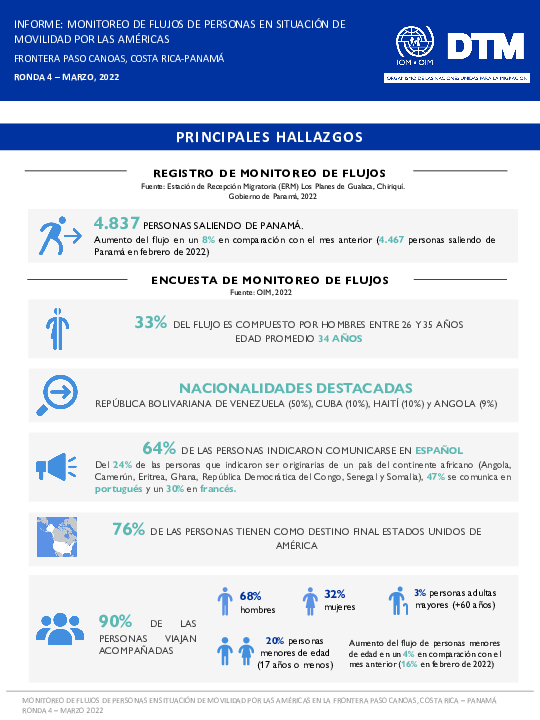
Contact
Angelica Madrigal amadrigal@iom.int / Miranda Mora mmora@iom.int
Language
Spanish
Location
Costa Rica
Period Covered
Mar 01 2022
Mar 31 2022
Activity
- Flow Monitoring
En el marco de la emergencia por la COVID-19, desde el 19 de marzo del 2020, el Gobierno de Costa Rica mantiene cerrada su frontera terrestre con Panamá para la Operación Binacional Flujo Controlado, la cual procuraba una migración ordenada y segura de personas migrantes en situación de movilidad por América3.
Desde agosto de 2021 y enero de 2022, han ingresado a Panamá 93.139 personas migrantes: Haití (61%), Cuba (11%), Chile y Brasil con 7%, República Bolivariana de Venezuela (4%), entre otros países del Sur de América, África y Asia (10%).
En Costa Rica, durante el 2022, se ha identificado un aumento constante en la cantidad de personas migrantes de este flujo migratorio (ha aumentado en un 26% en comparación con diciembre, 2021, cuando inició el monitoreo de flujos en Costa Rica). Además, de acuerdo con datos de la Dirección General de Migración y Extranjería (DGME), durante mayo de 2021 y febrero de 2022 se han realizaron 5.331 rechazos5 en Paso Canoas.
En Costa Rica se perciben muchas vulnerabilidades: personas viajando solas, niños y niñas, personas adultas mayores desorientadas, personas con problemas médicos, desgaste emocional ocasionado por estrés, angustia y frustración. Además, las principales necesidades detectadas se asocian con el acceso a alimento, ropa, pañales, alojamiento, medicamentos y transporte. Muchas personas han perdido sus documentos de identificación y se reúsan a recibir asistencia médica, pues consideran que no se les permitiría continuar con su viaje.

Contact
DTMAfghanistan@iom.int
Language
English
Location
Afghanistan
Period Covered
Dec 04 2021
Jan 01 2022
Activity
- Other
This report provides a snapshot of the third round of RLS data collection, as well as a comparison of data that was collected among those returnees who also participated in the second round (September-October 2021). Round 3 of RLS data collection took place between 4 December 2021 and 1 January 2022 with Afghan migrants who returned from Turkey or the EU between January 2018 and July 2021. 666 returnees (577 from Turkey and 89 from the EU) were interviewed in-person and over the phone across 92 districts in 15 provinces.
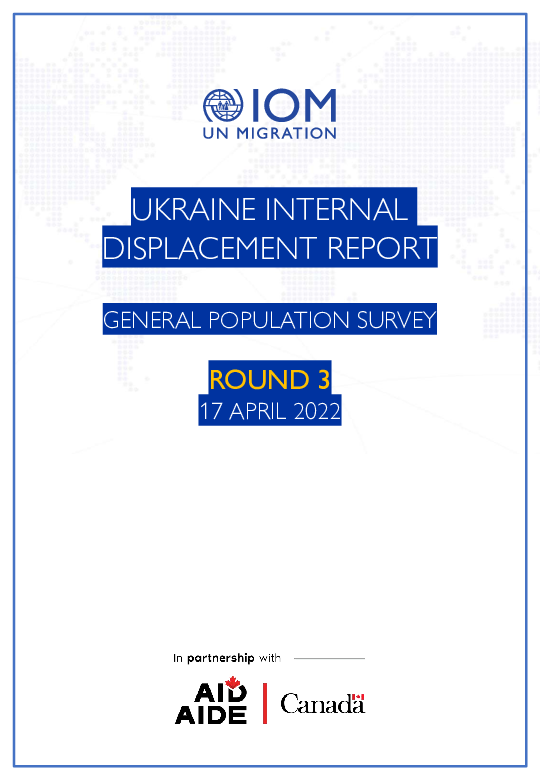
Contact
DTMUkraine@iom.int
Language
English
Location
Ukraine
Period Covered
Apr 11 2022
Apr 17 2022
Activity
- Survey
Starting on 24 February 2022 the war in Ukraine triggered an unprecedented humanitarian crisis across all of the country’s sub regional divisions (oblasts). Between 11 April and 17 April the International Organization for Migration (IOM) conducted the third round of a rapid representative assessment of the general population in Ukraine to gather insights into internal displacement and mobility flows, and to assess local needs. This general population survey serves as a preliminary source to identify areas with high humanitarian needs and to inform the targeting of response aiming to assist the war affected population. The geographical scope of the assessment covers the entire territory of Ukraine, all five macro regions ( East, North, Centre, South, and the city of Kyiv), with the exception of the Crimean peninsula. The general population survey was constructed through a random-digit-dial (RDD) approach, and 2,000 unique and anonymous respondents aged 18 and over were interviewed using the computer-assisted telephone interview (CATI) method. The estimates rely on the UNFPA population data for Ukraine, agreed upon as the common population baseline by the humanitarian community. Those currently outside Ukraine were not interviewed. For further notes on method and limitations, including IOM’s definition of internally displaced persons used for the purpose of this assessment, see page 11.
This report is also available in Ukrainian.
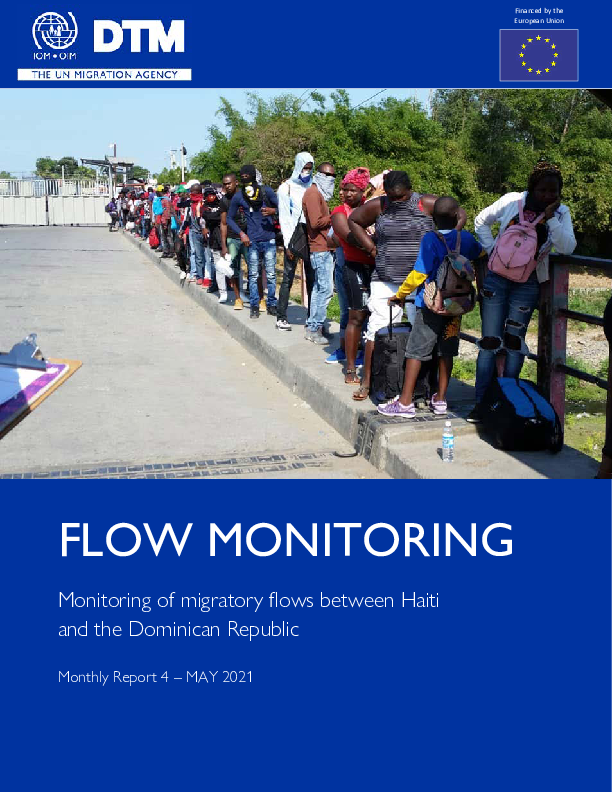
Contact
DTM Haiti, DTMHaiti@iom.int
Language
English
Location
Haiti
Period Covered
May 01 2021
May 31 2021
Activity
- Flow Monitoring
The migration flow between Haiti and the Dominican Republic (DR) in the island of Hispaniola is highly active and challenging as it is estimated that over half a million foreign born persons are living as irregular migrants in the DR, the vast majority of which - (497,825 persons)1 - being from the neighboring Republic of Haiti. Consequently, migration management between Haiti and the Dominican Republic and the protection of vulnerable migrants remains a major challenge on the island.
Due to the significant influx of returnees and in support of the Government of Haiti, IOM Haiti has established a Displacement Tracking Matrix initiative which focuses on reinforcing monitoring and data collection of border movement between the two countries. Border & Flow Monitoring aims to provide information on cross border returns of migrants from the Dominican Republic into Haiti and support the systematic identification, registration and profiling of Haitian migrants returning and/or being deported at all border crossing points with the DR in to provide key information on risks, needs and migration patterns. The previous application of the Border and Flow Monitoring monitored migratory flows on 50 Border Crossing Points – 4 official and 46 unofficial. The current one covers 20 Border Crossing Points – 4 official and 16 unofficial in collaboration with the Support Group for the Repatriated and Refugees (GARR2 in French).

Contact
dtmhaiti@iom.int
Language
English
Location
Haiti
Period Covered
Jun 01 2021
Jun 15 2021
Activity
- Flow Monitoring
The COVID-19 outbreak first reported in the People’s Republic of China in late 2019 was declared a pandemic by the World Health Organization (WHO) on 11 March 2020. More than a year later, as of 15 June, approximately 176,000,000 confirmed cases had been reported in 213 countries, areas or territories according to WHO and the neighboring country Dominican Re public already reported that 311,833 individuals tested positive to the virus with 3,726 who have died from the disease. On 20 March 2020, the first two cases were confirmed in Haïti and the country remains at high risk of rapid contagion given the weak health system, the proximity and porous border with the Dominican Republic. At present, 17,239 cases of infection, 373 deaths and 12,645 recoveries have been confirmed in Haïti.
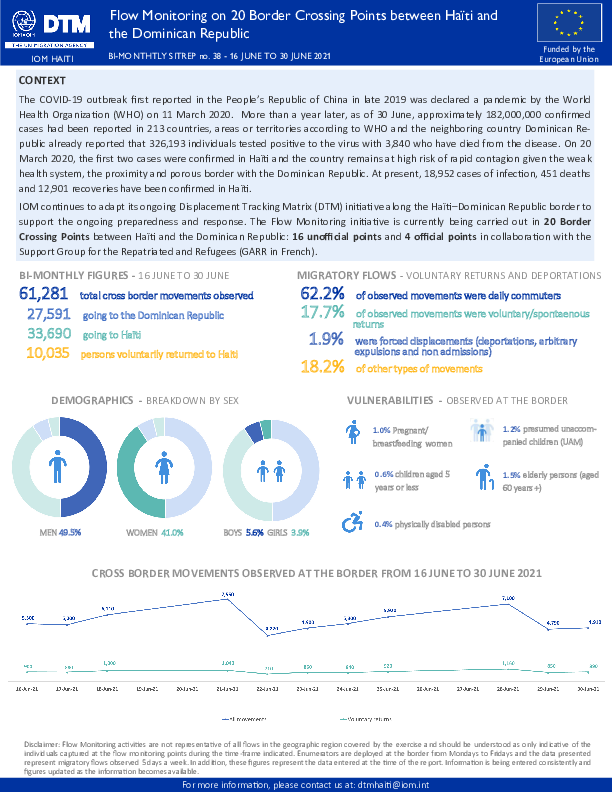
Contact
dtmhaiti@iom.int
Language
English
Location
Haiti
Period Covered
Jun 16 2021
Jun 30 2021
Activity
- Flow Monitoring
The COVID-19 outbreak first reported in the People’s Republic of China in late 2019 was declared a pandemic by the World Health Organization (WHO) on 11 March 2020. More than a year later, as of 30 June, approximately 182,000,000 confirmed cases had been reported in 213 countries, areas or territories according to WHO and the neighboring country Dominican Republic already reported that 326,193 individuals tested positive to the virus with 3,840 who have died from the disease. On 20 March 2020, the first two cases were confirmed in Haïti and the country remains at high risk of rapid contagion given the weak health system, the proximity and porous border with the Dominican Republic. At present, 18,952 cases of infection, 451 deaths and 12,901 recoveries have been confirmed in Haïti.

Contact
dtmhaiti@iom.int
Language
English
Location
Haiti
Period Covered
Jul 01 2021
Jul 15 2021
Activity
- Flow Monitoring
The COVID-19 outbreak first reported in the People’s Republic of China in late 2019 was declared a pandemic by the World Health Organization (WHO) on 11 March 2020. More than a year later, as of 15 July, approximately 189,000,000 confirmed cases had been reported in 213 countries, areas or territories according to WHO and the neighboring country Dominican Republic already reported that 336,693 individuals tested positive to the virus with 3,910 who have died from the disease. On 20 March 2020, the first two cases were confirmed in Haïti and the country remains at high risk of rapid contagion given the weak health system, the proximity and porous border with the Dominican Republic. At present, 19,762 cases of infection, 523 deaths and 13,332 recoveries have been confirmed in Haïti.
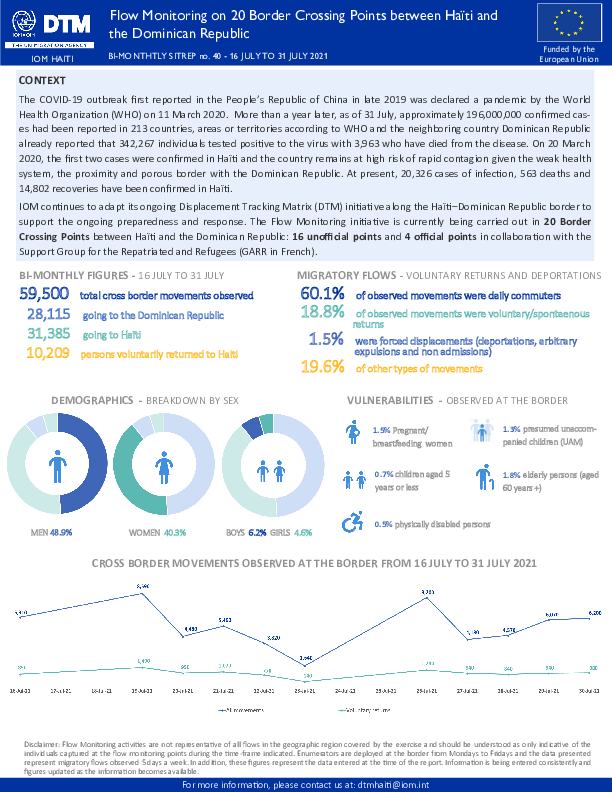
Contact
dtmhaiti@iom.int
Language
English
Location
Haiti
Period Covered
Jul 16 2021
Jul 31 2021
Activity
- Flow Monitoring
The COVID-19 outbreak first reported in the People’s Republic of China in late 2019 was declared a pandemic by the World Health Organization (WHO) on 11 March 2020. More than a year later, as of 31 July, approximately 196,000,000 confirmed cases had been reported in 213 countries, areas or territories according to WHO and the neighboring country Dominican Republic already reported that 342,267 individuals tested positive to the virus with 3,963 who have died from the disease. On 20 March 2020, the first two cases were confirmed in Haïti and the country remains at high risk of rapid contagion given the weak health system, the proximity and porous border with the Dominican Republic. At present, 20,326 cases of infection, 563 deaths and 14,802 recoveries have been confirmed in Haïti.

Contact
dtmhaiti@iom.int
Language
English
Location
Haiti
Period Covered
Aug 01 2021
Aug 15 2021
Activity
- Flow Monitoring
The COVID-19 outbreak first reported in the People’s Republic of China in late 2019 was declared a pandemic by the World Health Organization (WHO) on 11 March 2020. More than a year later, as of 15 August, approximately 205,000,000 confirmed cases had been reported in 213 countries, areas or territories according to WHO and the neighboring country Dominican Republic already reported that 346,459 individuals tested positive to the virus with 3,985 who have died from the disease. On 20 March 2020, the first two cases were confirmed in Haïti and the country remains at high risk of rapid contagion given the weak health system, the proximity and porous border with the Dominican Republic. At present, 20,732 cases of infection, 583 deaths and 16,866 recoveries have been confirmed in Haïti.

Contact
DTM Haiti, DTMHaiti@iom.int
Language
English
Location
Haiti
Snapshot Date
Sep 03 2021
Activity
- Mobility Tracking
At 8:30am (GMT-4) on 14 August, a deadly, shallow earthquake rocked southwestern Haiti just 12km northeast of Saint-Louis du Sud, about 125 kilometers west of the capital Port-au-Prince. The quake severely affected buildings and homes and damaged critical infrastructure and roads, cutting off access to some areas in the southwest, such as national road 7, which connects Les Cayes and Jeremie. As of 25th August, the Haitian Civil Protection General Directorate (DGPC) reports more than 52,953 collapsed building and 77,006 in need of reparation, including at least 25 health facilities, 127 schools and 60 religious buildings so far. DGPC also reports at least 2,207 deaths, approximately 12,268 more injured and 320 persons missing. In addition, at least 650,000 people are in need of humanitarian assistance. The Sud, Grand'Anse and Nippes departments, particularly the cities of Les Cayes, Jeremie and Anse-a-Veaux, were hardest hit, suffering extensive damage and destruction to buildings and homes.
In response, IOM has activated its displacement monitoring tool, the Displacement Tracking Matrix (DTM) in the affected départements – Nippes, Sud and Grand’Anse – in close coordination with the General Directorate for Civil Protection (DGCP). The current DTM activities aim to gather basic information on possible displacement locations, assess damages sustained to buildings following the earthquake and understand mobility caused by this event.